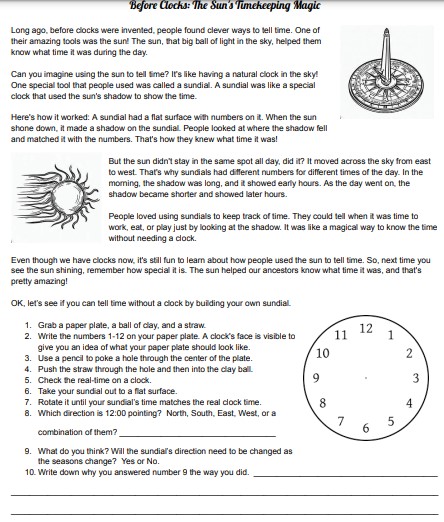Before Clocks: The Sun's Timekeeping Magic Reading Passage and Lab
Preview/Download

Long ago, people used the sun to tell time before clocks were invented. In this engaging reading passage and activity, students will learn about the fascinating world of sundials and how they were used to keep track of time.
This worksheet provides a fun and educational opportunity for students to explore the concept of sundials and their importance in ancient timekeeping. The worksheet includes step-by-step instructions for building a sundial using common materials such as a paper plate, clay, and straw.
Through hands-on exploration, students will assemble their own sundial, carefully placing the numbers on the paper plate and positioning the straw in the center. They will then take their sundial outside to a flat surface and align it with the real-time displayed on a clock. By observing the position of the shadow cast by the sun, students will determine the corresponding time on their sundial.
This activity promotes critical thinking skills as students analyze the relationship between the sun's position and the shadows created, making connections between time and the rotation of the Earth. They will also consider the directional aspects of the sundial, including the positioning of the 12:00 mark and whether it needs adjustment as the seasons change.
The worksheet includes thought-provoking questions to deepen students' understanding, such as identifying the direction in which 12:00 points and reflecting on whether the sundial's direction needs adjustment with changing seasons.
Students will write down their answers and explain their reasoning, fostering language development and communication skills.
This resource combines hands-on learning, critical thinking, and scientific inquiry to introduce young learners to the wonders of timekeeping using the sun. It is suitable for third-grade classrooms and homeschool settings, providing an interactive and memorable experience that connects the past with the present.
For more resources, labs, activities, videos, and worksheets, visit EducationalResource.org
